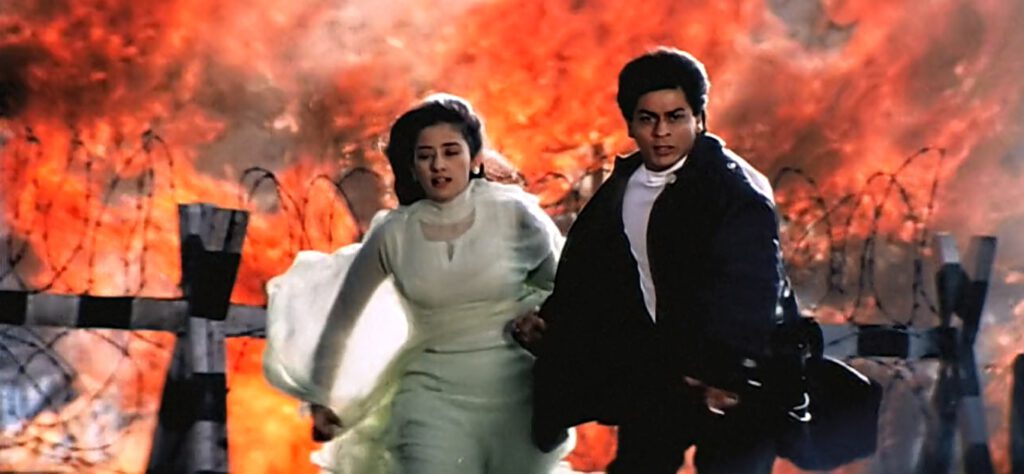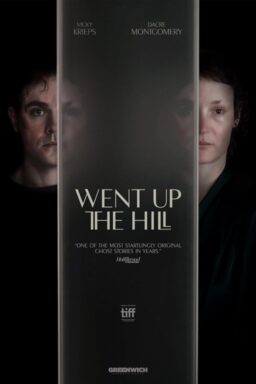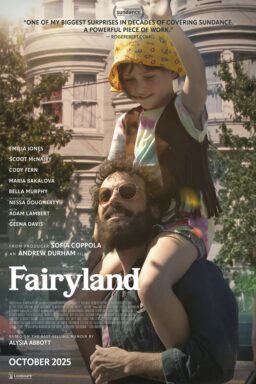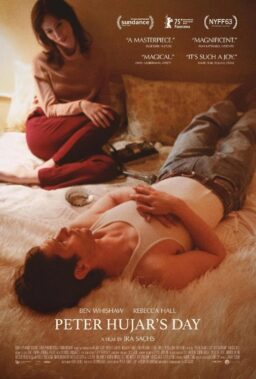Like millions of Indians, I went—with my aunt, brother, parents, and grandparents—to see Mani Ratnam’s “Dil Se” in theaters. Our movie theater of choice, in the autumn of 1998, was the Plaza in New Delhi’s Connaught Place. CP, as it was known by Delhites, was rumored to be part of the film’s setting, which rather excited us. We were already familiar with the killer soundtrack, created by the inimitable A.R. Rahman. The movie’s title song had become a running joke in our household, because my brother, then six years old, would sit in the drawing room as the soundtrack cassette played on the stereo, bobbing his head along in utmost concentration and singing “Dil seeeeeeeeee.” The film’s other bankable draw? Shah Rukh Khan, the king of the Indian box office throughout the 1990s and early 2000s.
Unfortunately, 1998 was too early, at least in India, for an avant garde film that was more intellectual than melodramatic, more literary than linear. The packed theater gasped in unison, horrified, when Khan—best known for insouciant mandolin-strumming and romancing heroines in verdant European fields—blew himself up with a bomb. And then, adding insult to injury, the credits rolled! I can still see the befuddlement on everyone’s faces as we began to pick our way through the empty plastic chai cups and crumpled samosa wrappers. As we filed out of the theater, thoroughly confused, I heard a grumpy auntie complain to her husband: “Imagine! We paid to watch Shah Rukh die!”
Needless to say, the film was a colossal flop in India.
It wasn’t until I was in high school, living on the other side of the planet, and had learned a bit more about history and human relationships, that I began to reconsider the movie. At some point, my father said “Dil Se” was better understood as visual jazz, rather than an ordinary Hindi film with a boilerplate storyline. His comment unlocked the puzzle of “Dil Se.” By the time I joined the cinema studies department in college, I knew the film (now available on Amazon Prime and Netflix) was a masterpiece.

In fairness to the average late 1990s Indian moviegoer, the film’s setup, on its surface, is not dissimilar to a romcom. Amar (Khan), a handsome and chatty radio reporter, meets a beautiful woman (Manisha Koirala, in a career-best performance) on a train platform. The only thing stronger than Amar’s presence is the wind, which is rapidly increasing in speed and volume, bursting forth finally in a torrential downpour. In contrast to Amar’s brash extroversion, the nameless woman is quiet, almost completely hidden under a black shawl, and says nothing to him aside from, in response to his incessant inquiries, a request for a cup of tea. By the time Amar rouses a street vendor and sprints back to the platform with two glasses, she’s boarded a train. He spots her, seated with several men, as her carriage passes. He yells, “Oy!” Startled, she looks out the window. They exchange a look, and she’s gone. Cheerfully, in the happy-go-lucky style that’s long defined Khan’s acting, Amar says to himself, “The world’s smallest love story.”
And that’s where the similarities to any Hindi films before or since end. Amar, as part of his work for All India Radio, is traveling to Assam, a state in eastern India that is home to a militant separatist movement. The 25th anniversary of Indian independence is approaching, and he wants to ask an ignored part of the country how they feel about India’s progress since 1947. In a montage of such interviews, we learn this is clearly a thorny subject: an impoverished farmer is visibly enraged by the question, saying whatever progress has been made doesn’t benefit him; when Amar poses the question to a mother-daughter pair who are standing on a verandah, they begin fighting, the daughter saying progress has been made, the mother insisting not. Children appear to be patriotic, adults not so much. Interspersed through this work are Amar’s sightings and subsequent pursuit of the woman from the platform, whose name, we learn, may be Meghna.
Two narratives emerge: The first is a reporter’s journey into the politics of separatist states and their armed rebel groups. Repeatedly Amar pushes the norms of interviewing insurgency leaders, barraging them with questions that threaten his physical safety. Khan is no stranger, in his roles as a leading man, to talking long after he should’ve stopped. Amar appears aware that the Indian government mistreats regions protesting their marginalized status. What he is not aware of, however, is how he himself perpetuates this pattern with Meghna. His obsession exists in perfect contrast to her. She says very little in the film’s first two acts, certainly nothing too revealing about who she is or what she wants, but she is adamant about the fact that she wants Amar to leave her alone. Outwardly, she is reserved and shy. Her interior, however, is like the separatist states’: brutalized, harassed, and so wrathful that the hint of a spark could ignite a catastrophic explosion.
Recently I watched the film with my (white) boyfriend, who’d never seen it. He mistook the actress who dances with Khan during “Chaiyya Chaiyya,” the movie’s best known song, as Meghna. I was annoyed by this, since Malaika Arora and Manisha Koirala don’t look the least bit alike, but I pointed out the necessity of the latter’s absence in that first song. The presence of an attractive woman who is merely standing in for Meghna is important, because Amar’s love is entirely one-sided. We have not a single syllable of dialogue in the film that speaks to Meghna’s feelings about Amar. Her participation in this “love” is imagined entirely by him, and not borne out by any reality. All we have is her desperation that he should leave her alone. All he knows is that he wants her.
Shah Rukh Khan has made a career out of playing confident jocks who are redeemed only by the humility of falling in love. For much of his Yash Chopra/Karan Johar output, Khan is on autopilot, winning over hundreds of millions of viewers with those big warm brown eyes, that perfect “aw shucks” grin,” the thick black locks he has to push off his forehead. But in Ratnam’s story, Khan’s traditional typecasting is skewed brilliantly by the very ideology—handsome, romantic everyman—he represents. Khan usually plays men whose arrogant ignorance observes a redemptive path, but here, Amar has no such evolutionary arc. One of my favorite exchanges in the film takes place between him and a separatist militia leader, to whom, during an interview, he says, “You look just like us. I mean, normal.”
The leader responds, nonplussed: “What did you think we’d look like?”

Amar’s refusal to stop stalking Meghna is emblematic of his character’s self-centered mindset. Right after calling her, in Hindi, a “fast girl”—a misogynistic insult, and one Meghna has done nothing to deserve—he sexually assaults her, which triggers her post-traumatic stress disorder. It’s one of the film’s best scenes, as Koirala’s Meghna, unable to speak, juts out her face and through a frozen open mouth, emits high pitched shrieks that to this day chill my soul. As a child, I found the scene bizarre and confusing. As an adult survivor of rape, every time I watch the movie I gain new respect for the scene’s ability to convey trauma through a single unbroken shot. If no record of Koirala’s acting career except “Dil Se” remained, she would still go down as an all-time great performer. Amar frantically flaps around, asking questions she cannot possibly answer: “Why won’t you say anything? Has this happened to you before? Why can’t you stop?” His pursuit is vividly analogous to India’s treatment of marginalized regions that lobby the national government for independence. Amar is even from New Delhi, thus completing his arc as an asshole from the heart of the nation, endlessly following, harassing, and even assaulting the woman who just wants to be left alone.
The essential dichotomy that results from the film’s twin narratives is choices versus destiny. When a character asks why Meghna doesn’t find a boy to marry, Meghna replies sadly but matter of factly: “It’s not in my stars.” Amar’s entire being contrasts with such thinking. Over and over, he urges her to abandon everything, marry and run away with him. She, in his mind, can make that choice. He is unwilling to stop and ask her opinion, unable to prioritize her wants above his, unable to let go of her. Meghna’s own agency is limited by Amar’s persistence. I imagine, if I were to ask people living in Jammu & Kashmir or in Assam how they feel about the brute strength of the Indian government’s influence on their lives, they might say something similar.
In the days after we saw “Dil Se,” my family joked that hey, it wasn’t all bad, at least Rahman did the music. Indeed, the composer’s work on other films saved them from being relegated to dustbins. The only reason we never walked out on, say, “Taal” and “Sapnay” is because of Rahman’s score. “Dil Se,” however, is the rare, already brilliant movie that achieves transcendence because of Rahman. Song by song, note by note, he explores the exuberance and despondence of passion. “Satrangi Re”—which translates roughly to “Seven-Hued Beloved”—courses with madness, a didgeridoo, and Sonu Nigam’s desperate pleading vocals, all deepening Amar’s obsession. Farah Khan’s intense experimental choreography, an unusual mode for her work even now, adds to the song’s pervasive haunting. It took me 23 years to notice that Koirala, during the song, cycles through seven differently colored costumes. Rahman also employs operatic vocals—sung in both Hindi and Tamil by the one and only Sukhwinder Singh—that ring out like cosmic pleas careening through the vast emptiness of heartbreak, perfect for the sequences set in the Leh Region of India. Amar and Meghna’s conversations are scored by plucky strings and a dark bass line, pulsating with ominous depth, underscoring that even their simplest encounters are tainted by danger.
Throughout, the soaring vocals suggest a despair that is both beautiful and fatal. “Ae Ajnabi”—translates to “Oh Stranger”—is a spare ballad of longing that is the closest thing to Meghna’s opinion on her predicament. She does not sing the song, merely hears it on the radio, as Amar plays it after creating a short radio play about their meeting. “I live broken and in pieces,” sings Udit Narayan in yet another career-best performance, “and you, somewhere, are in pieces too.” Koirala embodies the song perfectly: she stumbles gently, clearly moved, distraught, toward the radio, turns it off, turns it back on, and turns it off again. The title song is a glorious anthem, sung by Rahman himself, and nearly perfect in execution: an instantly catchy, up-tempo rock song through which Amar and Meghna live out a fantasy of love in the face of, in the midst of, in spite of, war. The song’s stubborn refusal to give up the joys of life is truly angelic: the thumping beats back children, as they race down streets obliterated by bombs and cordoned with barbed wire, determined to dance. Still, there is a hint of Amar’s actual futile pursuit of Meghna, who continually slips just out of his grasp throughout the song.
At the end of “Dil Se” Meghna runs into Amar’s arms, happy and free, a dire inversion of their future. In truth, Amar and Meghna’s story is neither free nor happy, and Rahman manages both narratives with verve. So extraordinary is Rahman’s work here that even the background score is inextricably linked to the film’s feel. The title credits, which do not have visuals of any kind, feature a folk melody sung by a chorus of children, the peaceful trickle of a creek, cut through with the crash of thunder, bullets, helicopters, tortured screams, and explosions. Tribal drums begin to beat, increasing in speed, indicative of the chase we are about to witness. It’s a kaleidoscopic introduction to life in separatist Indian states, where the beauty of indigenous traditions have been permanently damaged, but not destroyed, by state violence. When I listen to this introductory composition, over 20 years after first hearing it in a New Delhi theater, I am in awe of its visionary scope and deeply felt genius.
In the decades since, Rahman’s near-flawless score has stood the test of time like few film compositions, in any language. When my parents took my brother and I to see the Spike Lee movie “Inside Man”—a big deal, since this was the first time we were watching an R-rated film with them—we almost got up and started cheering when “Chaiyya Chaiyya” began playing during the opening credits. No one but us knew the source of the movie. Oh! how we burst with pride, as those around us merely enjoyed this song they neither recognized nor understood. The pleasing infectious whooshes, thumps, and claps of “Chaiyya Chaiyya” match the sprightly optimism of love’s first blush. (Interestingly, Ratnam heard the finished recorded version of the song before the song had been filmed; upon hearing it, he decided to film it atop a train. The song employs neither special effects nor CGI.) It goes without saying that the song is a classic, beloved in countries all over the world, by people who’ve never seen the movie, by people who don’t know what Hindi or even Urdu sound like.
“Chaiyya Chaiyya” is a reworking of “Thaiyya Thaiyya,” a poem by the 17th century Punjabi philosopher and Sufi poet Bulleh Shah. The Indian lyricist Gulzar, whom I would never disrespect by writing about only parenthetically, rewrote the lyrics, and added a new title. In the context of the song, “chaiyya” refers to the shade (“chaya”) over the heads of those in love. “Chal chaiyya” means “let’s go toward the shade,” and is a good example of what I call a Gulzarism: an onomatopoeic spin on a word to make it a noun, verb, and a sentence. Adding to the film’s cosmopolitan nature, the influence of Sufi Islam makes itself known in both the film’s lyrics, its music (Rahman is Muslim and his work frequently references Sufi artistry), and its story structure, which matches the stages of love in Arabic literature. Unfortunately for the eager moviegoers of 1998, these very stages begin, optimistically enough, with attraction, but end in junoon (madness) and maut (death).
It’s easy to dismiss Indian cinema with the label of “Bollywood.” The term carries rigid stereotypes: a lengthy run time; actors frolicking in Dutch tulip fields or at lavish loud weddings; melodramatic boy-meets-girl fodder; and songs about love. To be sure, this type of movie certainly exists, and in abundance, but that means deviations from the pattern have the power to rewrite a moviegoer’s horizon of expectations. “Dil Se” was brave enough to exist in opposition to Hindi cinema conventions long before experimental movies about partisan violence became commonplace. India’s independent film scene has provided some of the best and most thought-provoking cinema from the subcontinent since the 1970s, but the resurgence of partisan riots—starting in the late 20th century and sadly, continuing to the present—have propelled the postcolonial film form to new heights. Without “Dil Se,” we wouldn’t have Rahul Dholakia’s “Parzania” or Chandraprakash Dwivedi’s “Pinjar.” The cinema of my home country often caters to the needs and wants of its audience, for better and for worse. The crowd of strangers at the Plaza in 1998 wanted to forget its cares, wanted to laugh, wanted to cry, wanted to root for or against someone. What we didn’t understand was “Dil Se” giving succor to an entirely new audience experience—the need to be challenged.
“Dil Se” is now streaming on Amazon and Netflix.












